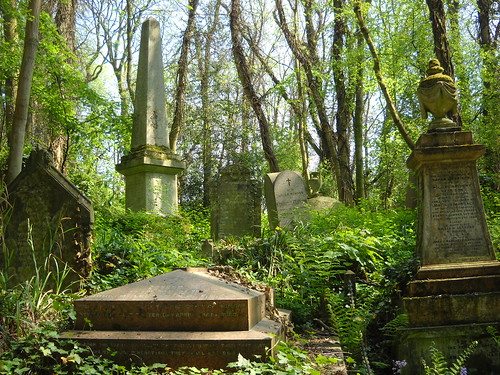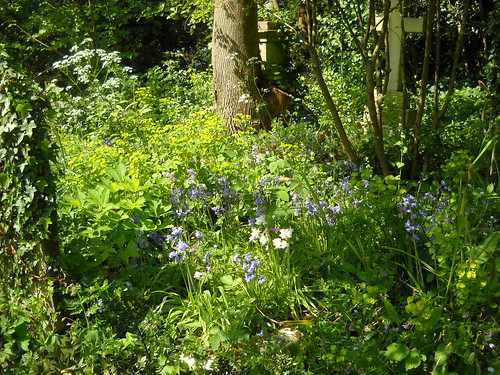Really.
They can be fascinating places, cemeteries. Just think about all the history buried beneath your shoes. The really creepy ones provide endless inspiration for ghost stories and haunted fables. I don't go in for the blood-and-guts type stories that tinsel town churns out, but with a good imagination you can find mystery, intrigue, even romance.
Cemeteries and gardens have a lot in common. Cemeteries, like gardens, can be places of beauty designed to provoke an emotional response and the older ones are increasingly in need of care and management to maintain their spirit. So when the invitation to spend a day gardening with a volunteer group at historic Highgate Cemetery in north London presented itself, I signed on immediately! Even having perused the website, I was completely unprepared for the visions that greeted me.
Designed by architect Stephen Geary who appointed David Ramsey as landscape gardener, Highgate was opened in 1839 as part of a Parliamentary Act providing seven modern cemeteries (they were known as "The Magnificent Seven" back then) serving the London populace because the small church graveyards were becoming over-crowded and posed severe health hazards (ya think?).
Highgate is divided into two parts entered through the East Gate and West Gate respectively. Victorians much admired the new place and if it were appropriate to call a cemetery fashionable, Highgate became so (and when you think about it, by definition death is pretty fashionable. I mean, everyone does it...). Soon the land became a garden of Gothic graves with elaborate tombs and memorials sprouting up one after another. Situated on the side of a south-facing slope, it once commanded a majestic view of London.
 |
| Highgate, view from the terrace c. 1850 by R. Hind |
Not so now.
 |
| Note, this is the same Cedar of Lebanon tree shown in the 1850 illustration! |
With the onset of WW1 the men who maintained the immaculate grounds at Highgate were called up to action. Coupled with the desire for less elaborate and ostentatious funerals, the cemetery began to fall into a state of decline in the 1930s. Funds ran out in the early 1970's. In 1975 the Friends of Highgate Cemetery Trust was established and acquired ownership of the cemetery and it is they who now oversee management of the grounds. The cemetery is a Grade 1 English Heritage site and several of the chapels, monuments, tombs, and catacombs have also been listed.
A new management plan was adopted and is being tackled section by section with the view of maintaining the cemetery as a sanctuary for wildlife while preserving respect for the grave oweners, not a complete restoration to a Victorian cemetery (which would take millions of pounds and an army to accomplish). First a major clean up took place to remove fallen trees, dead wood, pruning up of low holly branches, and releasing statuary and sculpture from the ivy's embrace. The next phase included planting of native trees and shrubs such as Rowan (Sorbus aucuparia, appropriately known as the Tree of Life) and Ruscus aculeatus. Other hardy natives such as Carex pendula are controlled by thinning (the Collins Flower Guide notes the habitat of this particular sedge as 'damp woodlands on heavy soils, hedgerows, sides of ponds and stream.' I would like to add, 'grows happily over gravestones').
With light shining once again on the ground below, wildflowers have appeared and the blooms of Cow Parsley (Anthriscus sylvestris), Euphorbias, Forget-Me-Nots, Bluebells, and Scillas illuminate the landscape.
There is still much to be done, and it was heart breaking to see so many beautiful monuments shrouded in ivy that my Felcos were itching to have a go at the tangled stems but several of the stones have lead lettering embedded in them, and removal of the vines needs to be a slow and careful process to extract the invader and preserve the integrity of everything underneath. Surgery on the graves of the dead. What a thought! There is a delicacy that is required when working in such a densely populated area and it's a sure bet that when you feel the chunk of your spade on rock, the stone is some one's grave marker, not just a rock in the soil! It's also a sure bet that one reads way too many novels when one imagines the occupant of said grave raising the lid and mildly enquiring, "Do you mind? I'm trying to sleep!"

Volunteer work days are held once a month, and an organization called Go-London has gotten involved so that on the day I volunteered there were at least 20 of us hauling away dead brush, pulling weeds, rescuing the Ruscus, controlling invasives and bringing the place back to life, as it were.
Tours are offered to see the cemetery and if you're planning a day in London, I highly recommend it. Better yet, if you're a local, contact them and volunteer for one of the working parties. It was a great experience and a truly unique way to see one of the most mysterious and magical historical sites of London.





No comments:
Post a Comment